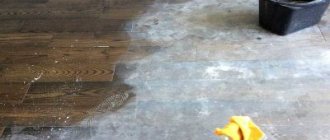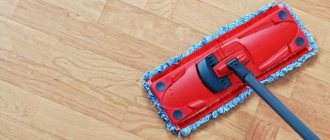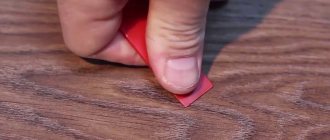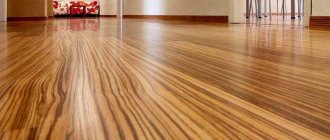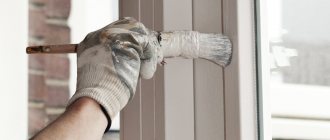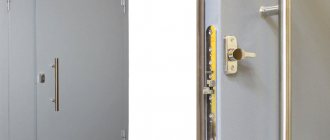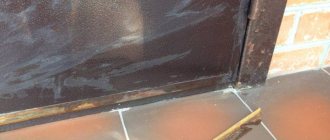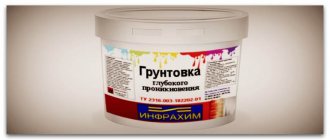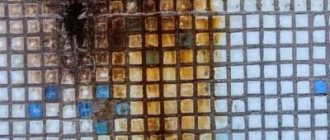Floors made of tiles and porcelain stoneware “please the eye” only when perfectly clean
Any contamination - be it shoe marks, frozen splashes of grease or limescale - gives the coating a sloppy appearance and spoils the overall impression of the interior.
In this article we will tell you how to clean ceramic tile and porcelain stoneware floors quickly and without streaks. We will recommend effective cleaning products for floor tiles in the bathroom, kitchen and hallway. We'll tell you how and how to clean tile floors from household and construction contaminants.
Porcelain tile cleaning products
The Cleanfix company offers effective professional products for washing and cleaning porcelain tiles.
Ceramic granite obtained from slip is a material characterized by high hardness and resistance to chemicals. The material is resistant to mechanical stress, tolerates temperature changes well and is resistant to moisture, which allows it to be widely used for both interior and facade decoration. However, it also has its conditional disadvantages. The “weak link” of porcelain stoneware is its porous structure. In this regard, it is quite vulnerable, since with irregular and unprofessional care, the risks that the micropores of the surface will become clogged with dirt and grease are quite high. The products we offer for cleaning porcelain tiles, if used correctly and continuously, will reduce such risks to zero, and ensure perfect cleanliness for polished or unpolished porcelain tile flooring.
Protection of porcelain tile floors
If the room is being renovated, the porcelain stoneware floors must be covered with protective materials. Otherwise, a dropped tool or other heavy object can split the tile and leave permanent scratches and chips on it.
It is enough to lay cardboard sheets from household appliances or, at worst, plastic film. Repairs are always accompanied by dirt and dust, so the film will protect the tiles from scratches left by particles of sand and concrete chips.
Porcelain floor tiles require protection from street dirt, which is brought into the room along with shoes. Owners of such floors should use rugs at the entrance to the house and warn guests not to walk on the tiles with boots.
If a floor lined with porcelain stoneware becomes dirty, this is not a problem for the tile itself. In this case, the tile joints suffer more, especially if they are made of cement-based grout.
The penetration of acids into these places leads to the destruction of the cement binder, resulting in a deterioration in the decorative qualities of the cladding. Therefore, during the operation of such surfaces, dirt should be removed from the tile joints in a timely manner and aggressive liquids should not be allowed to enter.
Cleaning products for porcelain tiles
The choice of a specific product for cleaning porcelain stoneware is, first of all, determined by the method of treating the surface of this material. However, the result of the installation work itself is important - their consequence is often all kinds of traces from glue and grouting materials, as well as cement. All these almost inevitable traces of repair and finishing can be quickly removed using porcelain tile cleaning products produced on the basis of inorganic acids. Depending on the specifics of the task, they can be used in concentrated form or as working solutions - porcelain stoneware perfectly withstands the effects of acids. Removal of cement, glue, and “excess” grout can be done manually or by machine. After washing with an appropriate solution, liquid dirt can be removed manually with a squeegee, mop, or machine - using a water vacuum cleaner. An example of such a cleaning agent is presented in our catalog - this is a highly concentrated acidic cleaning agent for porcelain tiles CERACID.
Types of contamination after repair
Fresh dirt during repairs can be easily removed with a wet cloth.
During repairs, ceramic tiles on the floor may become dirty:
- sealant;
- primer mixture;
- adhesive composition;
- grout;
- paint;
- putty;
- cement.
The listed substances can be easily wiped off from porcelain tiles with a wet cloth if this is done immediately as soon as the composition hits the tile.
When removing old stains, the process becomes much more complicated, because simple water with the addition of detergents cannot remove all types of contaminants. In such cases, you need to use special chemical compounds that can remove any dirt.
Methods for cleaning old contaminants
To remove old stains, you can resort to using a mechanical or chemical method:
- Mechanical – involves combating dirt using a knife, sandpaper or a construction float. When choosing this method, we must not forget about caution, because there is a possibility of damage to the tile covering. This cleaning method is used to remove lumps of cement, putty residues, and polyurethane foam.
- Chemical – involves soaking stains with solutions selected according to the type of contamination.
In the second case, you can use ordinary soap solution or industrial specialized products.
Cleaning products for polished porcelain tiles
Polishing provides porcelain stoneware with a magnificent aesthetic appearance - the floor covering, processed to a shine, has a noble, “expensive” and attractive appearance. However, this polished surface also has a downside - such porcelain tiles are more vulnerable to moisture. The fact is that when polishing, the molecular structure of the material is disrupted, micropores appear into which liquid dirt can easily get. But this problem can also be solved.
Alkaline porcelain tile cleaners reliably protect this material, polished to a shine. The alkaline composition copes well with dirt in micropores, destroying it “completely”, in addition, it preserves the ability of this porous material to “breathe”, which has a beneficial effect on the condition of the floor covering, the durability of the material, and its appearance. Washing the stone can also be done either manually (as part of regular cleaning) or by machine (usually during general cleaning).
How to choose the best option
Method of influence
On store shelves you can find powdered and liquid tile cleaning products. The first are abrasives that clean the contaminated surface through physical action. Solid particles create friction on the surface of the tile, removing dirt from it. Such products do an excellent job of the task and often clean even stubborn dirt.
But we must not forget about the downside of abrasive cleaning compounds: they can damage the tile surface, especially when it comes to glossy tiles. The powder breaks the top layer of the tile, leaving small scratches on its surface, often invisible to the eye: limescale accumulates in them, destroying the tile even deeper. The coating quickly loses its shine and presentable appearance.
A tile cleaner in the form of a liquid (gel, spray, paste, etc.) does not involve harsh physical, but chemical action. Removal of contamination occurs due to its reaction with the components of the cleaning product. If you choose the right option wisely, it will delicately and effectively clean the tiles of any dirt. Liquid formulations are considered the most popular and effective.
Compound
If the choice is made in favor of a non-abrasive product, it is important to determine the optimal one for yourself. There are acidic and alkaline options on the market. Products containing acid are ideal for removing inorganic contaminants (e.g. traces of rust or limescale). But you need to choose such compositions for tiles very carefully: if the tile contains limestone in its structure, an acidic product is not the best option. In addition, you should not use them for cleaning marble and granite stone.
Advice. Acidic compounds should be used with caution when caring for tiles whose seams are treated with calcium-containing grout and are not additionally protected.
Alkaline cleaners allow you to achieve more pronounced results than acidic ones. This option is optimal for removing soap and fat-based stains. The alkaline composition is considered universal: it is suitable for almost any tile. But here too you need to be careful. Sometimes manufacturers can add abrasive components (for example, soda) to the product, which have a detrimental effect on the glossy surface.
Coating features
It is the characteristics of the tiled covering that determine which product is best to purchase. Therefore, before purchasing a cleaning product, you need to study the composition of the tiles. If there is limestone among the components (or if it is a natural stone), you should immediately exclude all acidic cleaners from the possible options.
The room for which the cleaning product is intended also plays a role. Conventionally, household chemicals for tiles can be divided into options for bathrooms and kitchens. In the first case, the cleaner not only removes dirt from the coating, but also slightly illuminates its color.
Cleaning agents for untreated porcelain tiles
Unpolished porcelain tiles are also vulnerable to contamination because they have a rough surface as a result of rough processing. However, there are also tools for it that can be used to perform deep and effective cleaning. These concentrated alkaline cleaners are also presented in our catalog, for example CERA-CLEAN. Depending on the concentration, it can be used for daily or periodic machine cleaning, and also, if necessary, for intensive cleaning. In addition, in concentrated form, the product is perfect for removing stains.
You can check the prices for cleaning and washing porcelain tile products, ask other questions you are interested in, and also place an order by phone;.
Protecting glossy tiles
Porcelain tiles with a glossy surface are most vulnerable to damage. You need to take care of its condition immediately after finishing the facing work.
First of all, the tiles are treated with wax or other compounds that create a dirt-proof and moisture-repellent film.
This film gradually deteriorates, so treatment should be carried out once a month. In the absence of additional protection, glossy tiles will fade, become dirty and lose their former attractiveness.
Restoring its original appearance will be much more expensive and difficult compared to periodic waxing.
Glossy tiles should not be used as flooring in damp rooms or near entrance doors. This is due to the fact that the smooth polished surface becomes very slippery when water gets on it.
Features of polishing porcelain stoneware slabs
Often, during long-term operation, high-quality cleaning and general cleaning are not enough. The slabs gradually fade and lose their former shine. To restore purity, color, and brightness, polishing of porcelain stoneware is used. Special compounds are used that lift stubborn dirt to the top, invisible to the eye, but creating tarnish. The surfaces are cleaned with pads, followed by manual polishing with mops and cloths. A more expensive and time-consuming process for restoring the color and brightness of porcelain tiles is to use a sander and remove the thin top layer of the tile surface. This is a more complex process for restoring any floor covering. It is produced in several stages.
- Chips and microcracks are repaired with special solutions and pastes.
- The old grout between the tiles is cleaned off.
- The seams are filled with new compounds.
- Unevenness and roughness are ground and polished with a diamond disc.
- Spot grinding is carried out to remove small lifts and irregularities.
- The surface is again passed and polished with pastes to obtain shine.
- The coating is hydrophobized and protected.
The company Unified Cleaning Center provides services for the care of porcelain stoneware, tiles, and hard surfaces. To get a price for cleaning and cleaning tiles, leave a request or call us.
How to clean porcelain tiles?
There are few finishers who, after completing all work on site, would not have to eliminate side effects of their activities. No matter how careful the craftsmen are, splashes of primer, putty, paint and other finishing materials still end up on porcelain stoneware floors and walls and leave stains on them. How to clean up soiled porcelain tile cladding as quickly and efficiently as possible, so as not to “disgrace yourself” in front of the customer?
Before answering this question, it is necessary to remember what materials can contaminate porcelain stoneware during the finishing process. In addition to the already mentioned primers, putties and paints, these can be tile or other adhesives, polyurethane foam, as well as cement- or epoxy-based grouting compounds and, in a rare case these days, whitewash.
Actions of master finishers
Ideally, stains and splashes from the listed contaminants should be removed immediately after they appear on porcelain tiles. In this case, as a rule, it is enough to use a woven (or non-woven) napkin or sponge soaked in water. The exception is, perhaps, polyurethane foam, polyurethane adhesives and epoxy-based grout - here you cannot do without a solvent.
If you manage to eliminate fresh contamination, then in the future the final cleaning of the surfaces finished with porcelain stoneware will not be difficult. First you need to remove large fractions, then wipe the remaining dirt with a cloth and soapy water. This simple procedure must be repeated several times, periodically washing the napkin in running water. At the final stage, carefully wipe the tiles with a dry cloth.
It gets worse where you have to remove dried and old stains. In such a situation, you will have to use mechanical and chemical methods. The greatest difficulties are caused by the removal of old stains from porcelain tiles that have a polished or, conversely, textured, for example, lapped surface. Using mechanical action, you can remove lumps of cement glue, putty, polyurethane foam, and grout. A knife, plastic grater, or spatula are suitable for this. In this case, you need to act extremely carefully so as not to damage the surface of the tile. Porcelain tiles with polished and glazed surfaces are especially sensitive to mechanical damage. It is strictly not recommended to use abrasive products for mechanical cleaning - metal brushes, sandpaper, etc.
The chemical method of removing old stains mostly involves the use of chemically active substances selected based on the type of contamination. It is best to use cleaners produced by the world's leading manufacturers of construction chemicals. Cleaning compositions designed to remove a wide variety of stains from the surface of porcelain stoneware are produced by LITOKOL (Italy), MELLERUD (Germany), BELLINZONI (Italy), ATLAS CONCORDE (Italy), etc.
If for some reason you don’t have branded cleaners at hand, you will have to use folk remedies.
To combat dried or old stains, it is first recommended to make a compress from a napkin moistened with a cleaner.
In the case of polymer glue, an acetone-containing solvent or acetic acid can be used as a cleaner. Stains from cement and cement-based grout can also be removed with vinegar or another organic acid. At the same time, you need to ensure that acid or acetone does not get into the seam filled with grout, especially if it is colored. By the way, the world's major manufacturers of construction chemicals produce cleaners that, if they get into a seam, will not spoil the grout. In particular, the LITOKOL company produces such a composition called Litoclean Plus.
It is not recommended to use inorganic acids for dry cleaning - sulfuric, hydrochloric, etc., since all actions with them require increased safety measures.
To remove epoxy resin or compositions based on it, you will need a special solvent, for example, Litostrip (LITOKOL). To clean paint stains, you should choose a solvent that acts on its binder. Splashes and smudges of water-based paint are removed with water.
Whitewash stains are removed in several steps. First, the stained surface is washed several times with water. It is important that the water is changed all the time. Particularly contaminated areas are wiped with a sponge or cloth moistened with household detergents. Then the surface is washed again with water.
Polished tiles can be easily cleaned of whitish stains with a window cleaner containing alcohol.
So, the cladding is sparkling clean, the customer is happy, what next?
Note to home owners
Having received a brand new interior, every homeowner wants to keep it in its original form for as long as possible. Porcelain stoneware perfectly matches this aspiration due to the combination of unique operational properties inherent only to it. For example, porcelain stoneware from the Russian company ESTIMA Ceramica has a hardness of 7–8 on the Mohs scale. For comparison: diamond and corundum have 10 and 9 points, respectively.
The significant hardness of porcelain stoneware indicates a very high abrasion resistance of this material, and, accordingly, excellent wear resistance.
It is very important that porcelain stoneware has extremely low absorbency. In particular, the water absorption rate of ESTIMA Ceramica porcelain tiles is less than 0.5%. This means that porcelain stoneware is extremely insensitive to household pollution. This property is achieved, on the one hand, due to the density of the shard itself, on the other hand, due to the fact that during the production process the surface of the porcelain stoneware is treated with granils - special compounds that prevent wetting and the absorption of contaminants. Porcelain stoneware undergoes this procedure at the enterprises of ESTIMA Ceramica. In addition, each batch of porcelain tiles is tested in laboratory conditions for resistance to stains. That is why daily hygienic maintenance of porcelain tile cladding does not require serious effort - just wipe the surface with a damp cloth.
Still, porcelain tiles can accumulate dirt on the surface. This happens when the floor tiles are worn out during intensive use over several decades. To prevent the appearance of difficult-to-remove stains, it is recommended to periodically wipe the floor with protective agents containing beeswax or artificial wax, as well as special polyurethane-based emulsions. After this treatment, all dirt is removed using ordinary water. Protective compounds that prevent the accumulation of dirt are produced by companies that produce cleaners for ceramics, porcelain tiles and natural stone.
In conclusion, a few more tips. To make the surface lined with porcelain stoneware shine, it is recommended to add lemon juice or essential oils contained in lemon peels to the washing water. The same effect can be achieved by pouring a little acetic acid into the water.
It is better to clean porcelain tiles with a textured surface using a steam generator or a steam vacuum cleaner. After removing dirt, the surface of the tile should be wiped with a dry cloth.
As you can see, the timely removal of contaminants from porcelain stoneware surfaces and their preventive maintenance during operation is not difficult and significantly makes life easier for decorators and interior owners, and also, importantly, does not require significant effort and large financial costs.
Care Tips
In order for the porcelain stoneware floor or walls to remain in excellent condition for as long as possible, certain care rules must be followed:
- periodically treat the surface with wax-based compounds;
- annually use a special product designed to protect porcelain stoneware;
- to add shine, wash with lemon juice or vinegar solution;
- You can polish the glossy surface with a piece of felt cloth;
- unpolished porcelain tiles with a rough surface are cleaned using a steam generator, followed by treatment with a dry rag. It is better to clean immediately after contamination occurs.
- To ensure that there are no streaks left after washing porcelain tiles, it is enough to use glass cleaning products that contain alcohol.
To summarize, it can be noted that any contamination of porcelain stoneware is best removed without delay. But if you don’t have time, specialized products that can clean the surface of stains of any complexity will help.
POST-CONSTRUCTION CONTAMINATION ON PORCELAIN TILE
Renovation of premises and interior decoration generate a large amount of dust and construction residues on the tiles. Also, traces of grout, plaster, and many other mixtures can get on porcelain tiles. Below we list the most popular contaminants found in cleaning post-construction facilities.
- Acrylic paint, acrylic glue. These mixtures have high adhesion, are very viscous, difficult to dissolve, and are difficult to remove.
- Traces of soil mixtures, soil drops and stains. The primer is a material that needs to be washed off the tiles as quickly as possible. Since it has great ability to penetrate into the deep pores of tiles. Then it is difficult to lift them and wash them out of the tile coverings. Very labor-intensive and meticulous work.
- Drops of waterproofing, bitumen, and synthetic resins are also difficult to remove from porcelain stoneware and hard surfaces. It is necessary to dissolve them with solvents and technical cleaning chemicals in order to clean the dirt without damaging or damaging the surfaces.
- Traces of primer, plaster, and paint are often found in bathrooms and bathrooms. There may be traces of waterproofing. And also acrylic grout. It is generally not possible to remove it if the stain has been in place for more than 2-3 days. It is absorbed very deeply into the pores of the tile, which makes it easier to sand than to wash and oxidize the tile with aggressive solutions.
- Oil paint also requires cleaning and rinsing when cleaning after renovation.

